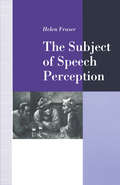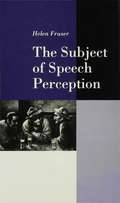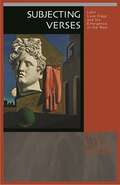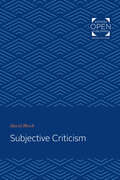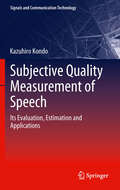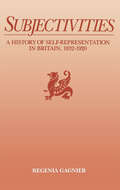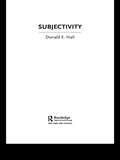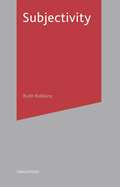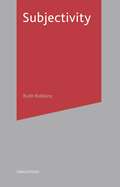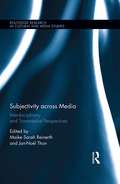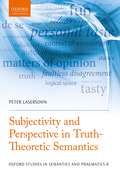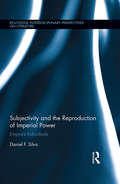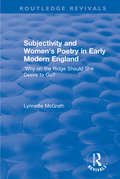- Table View
- List View
The Subject of Murder: Gender, Exceptionality, and the Modern Killer
by Lisa DowningThe subject of murder has always held a particular fascination for us. But, since at least the nineteenth century, we have seen the murderer as different from the ordinary citizen—a special individual, like an artist or a genius, who exists apart from the moral majority, a sovereign self who obeys only the destructive urge, sometimes even commanding cult followings. In contemporary culture, we continue to believe that there is something different and exceptional about killers, but is the murderer such a distinctive type? Are they degenerate beasts or supermen as they have been depicted on the page and the screen? Or are murderers something else entirely? In The Subject of Murder, Lisa Downing explores the ways in which the figure of the murderer has been made to signify a specific kind of social subject in Western modernity. Drawing on the work of Foucault in her studies of the lives and crimes of killers in Europe and the United States, Downing interrogates the meanings of media and texts produced about and by murderers. Upending the usual treatment of murderers as isolated figures or exceptional individuals, Downing argues that they are ordinary people, reflections of our society at the intersections of gender, agency, desire, and violence.
The Subject of Semiotics
by Kaja SilvermanThis provocative book undertakes a new and challenging reading of recent semiotic and structuralist theory, arguing that films, novels, and poems cannot be studied in isolation from their viewers and readers.
The Subject of Semiotics
by Kaja SilvermanThis provocative book undertakes a new and challenging reading of recent semiotic and structuralist theory, arguing that films, novels, and poems cannot be studied in isolation from their viewers and readers.
The Subject of Speech Perception: An Analysis of the Philosophical Foundations of the Information-Processing Model
by Helen FraserThis book analyses and challenges the metatheoretical framework which supports information-processing models of human speech perception. The first part consists of a review of speech perception research in the information-processing paradigm; an overview of the cognitivist philosophy from which this approach takes its justification; and an introduction to some relevant themes of phenomenological philosophy. The second half uses the phenomenological insights discussed to demonstrate some inadequacies of cognitivism; to show how these inadequacies underlie problems with the information-processing theory; and suggests an alternative framework with significant change of focus.
Subject of Speech Perception (PDF)
by Helen FraserThis book analyses and challenges the metatheoretical framework which supports information-processing models of human speech perception. The first part consists of a review of speech perception research in the information-processing paradigm; an overview of the cognitivist philosophy from which this approach takes its justification; and an introduction to some relevant themes of phenomenological philosophy. The second half uses the phenomenological insights discussed to demonstrate some inadequacies of cognitivism; to show how these inadequacies underlie problems with the information-processing theory; and suggests an alternative framework with significant change of focus.
Subject of the Event: Reagency in the American Novel after 2000
by Sebastian HuberWhat does falling in love have in common with the fall of the Berlin Wall? Or the fall of the Twin Towers? In the light of postmodernism's programmatic critique of a humanist notion of the subject and an emphatic understanding of events, Subject of the Event shows that selected American novels after 2000 offer an alternative to the "death of the subject.†? As the first book to comprehensively engage with Alain Badiou's writings outside of a philosophical context, Subject of the Event analyzes five critically acclaimed novels of the new millennium-Cormac McCarthy's The Road (2006), Jess Walter's The Zero (2006), Mark Z. Danielewski's Only Revolutions (2006), Paul Beatty's Slumberland (2008) and Thomas Pynchon's Against the Day (2006)-and argues that they create different 'subjects of the event' that are empowered with "reagency.†? The "subject of the event†? and its empowerment, what this book calls "reagency,†? implies that subjects only evolve out of their confrontation with the revolutionary impetus that events propel. Unlike a humanist capability of having agency, reagency is defined as a repetitive subjective praxis that is contingent upon events, which is given a concrete literary form in the novels under investigation. Sebastian Huber explores how the American penchant for events ("new beginnings,†? "clean slates,†? "apocalypse†?) is being critically dealt with in the novels at hand, while still offering an emphatic idea of singular disruptions that open up ways for subjects to affirm and become empowered by the new propositions of these happenings.
Subject of the Event: Reagency in the American Novel after 2000
by Sebastian HuberWhat does falling in love have in common with the fall of the Berlin Wall? Or the fall of the Twin Towers? In the light of postmodernism's programmatic critique of a humanist notion of the subject and an emphatic understanding of events, Subject of the Event shows that selected American novels after 2000 offer an alternative to the “death of the subject.” As the first book to comprehensively engage with Alain Badiou's writings outside of a philosophical context, Subject of the Event analyzes five critically acclaimed novels of the new millennium-Cormac McCarthy's The Road (2006), Jess Walter's The Zero (2006), Mark Z. Danielewski's Only Revolutions (2006), Paul Beatty's Slumberland (2008) and Thomas Pynchon's Against the Day (2006)-and argues that they create different 'subjects of the event' that are empowered with “reagency.” The “subject of the event” and its empowerment, what this book calls “reagency,” implies that subjects only evolve out of their confrontation with the revolutionary impetus that events propel. Unlike a humanist capability of having agency, reagency is defined as a repetitive subjective praxis that is contingent upon events, which is given a concrete literary form in the novels under investigation. Sebastian Huber explores how the American penchant for events (“new beginnings,” “clean slates,” “apocalypse”) is being critically dealt with in the novels at hand, while still offering an emphatic idea of singular disruptions that open up ways for subjects to affirm and become empowered by the new propositions of these happenings.
Subjecting Verses: Latin Love Elegy and the Emergence of the Real
by Paul Allen MillerThe elegy flared into existence, commanded the cultural stage for several decades, then went extinct. This book accounts for the swift rise and sudden decline of a genre whose life span was incredibly brief relative to its impact. Examining every major poet from Catullus to Ovid, Subjecting Verses presents the first comprehensive history of Latin erotic elegy since Georg Luck's. Paul Allen Miller harmoniously weds close readings of the poetry with insights from theoreticians as diverse as Jameson, Foucault, Lacan, and Zizek. In welcome contrast to previous, thematic studies of elegy--efforts that have become bogged down in determining whether particular themes and poets were pro- or anti-Augustan--Miller offers a new, "symptomatic" history. He asks two obvious but rarely posed questions: what historical conditions were necessary to produce elegy, and what provoked its decline? Ultimately, he argues that elegiac poetry arose from a fundamental split in the nature of subjectivity that occurred in the late first century--a split symptomatic of the historical changes taking place at the time. Subjecting Verses is a major interpretive feat whose influence will reach across classics and literary studies. Linking the rise of elegy with changes in how Romans imagined themselves within a rapidly changing society, it offers a new model of literary theory that neither reduces the poems to a reflection of their context nor examines them in a vacuum.
Subjecting Verses: Latin Love Elegy and the Emergence of the Real
by Paul Allen MillerThe elegy flared into existence, commanded the cultural stage for several decades, then went extinct. This book accounts for the swift rise and sudden decline of a genre whose life span was incredibly brief relative to its impact. Examining every major poet from Catullus to Ovid, Subjecting Verses presents the first comprehensive history of Latin erotic elegy since Georg Luck's. Paul Allen Miller harmoniously weds close readings of the poetry with insights from theoreticians as diverse as Jameson, Foucault, Lacan, and Zizek. In welcome contrast to previous, thematic studies of elegy--efforts that have become bogged down in determining whether particular themes and poets were pro- or anti-Augustan--Miller offers a new, "symptomatic" history. He asks two obvious but rarely posed questions: what historical conditions were necessary to produce elegy, and what provoked its decline? Ultimately, he argues that elegiac poetry arose from a fundamental split in the nature of subjectivity that occurred in the late first century--a split symptomatic of the historical changes taking place at the time. Subjecting Verses is a major interpretive feat whose influence will reach across classics and literary studies. Linking the rise of elegy with changes in how Romans imagined themselves within a rapidly changing society, it offers a new model of literary theory that neither reduces the poems to a reflection of their context nor examines them in a vacuum.
Subjecting Verses: Latin Love Elegy and the Emergence of the Real
by Paul Allen MillerThe elegy flared into existence, commanded the cultural stage for several decades, then went extinct. This book accounts for the swift rise and sudden decline of a genre whose life span was incredibly brief relative to its impact. Examining every major poet from Catullus to Ovid, Subjecting Verses presents the first comprehensive history of Latin erotic elegy since Georg Luck's. Paul Allen Miller harmoniously weds close readings of the poetry with insights from theoreticians as diverse as Jameson, Foucault, Lacan, and Zizek. In welcome contrast to previous, thematic studies of elegy--efforts that have become bogged down in determining whether particular themes and poets were pro- or anti-Augustan--Miller offers a new, "symptomatic" history. He asks two obvious but rarely posed questions: what historical conditions were necessary to produce elegy, and what provoked its decline? Ultimately, he argues that elegiac poetry arose from a fundamental split in the nature of subjectivity that occurred in the late first century--a split symptomatic of the historical changes taking place at the time. Subjecting Verses is a major interpretive feat whose influence will reach across classics and literary studies. Linking the rise of elegy with changes in how Romans imagined themselves within a rapidly changing society, it offers a new model of literary theory that neither reduces the poems to a reflection of their context nor examines them in a vacuum.
Subjective Criticism
by David BleichOriginally published in 1981. The meaning and objectives of literature, argues David Bleich, are created by the reader, who depends on community consensus to validate his or her judgements. Bleich proposes that the study of English be consciously reoriented from a knowledge-finding to a knowledge-making enterprise. This involves a new explanation of language acquisition in childhood, a psychologically disciplined concept of linguistic and literary response, and a recognition of the intellectual authority of pedagogical communities to originate and establish knowledge. Amplifying his theoretical model with subjective responses drawn from his own classroom experience, Bleich suggests ways in which the study of language and literature can become more fully integrated with each person's responsibility for what he or she knows.
Subjective Criticism
by David BleichOriginally published in 1981. The meaning and objectives of literature, argues David Bleich, are created by the reader, who depends on community consensus to validate his or her judgements. Bleich proposes that the study of English be consciously reoriented from a knowledge-finding to a knowledge-making enterprise. This involves a new explanation of language acquisition in childhood, a psychologically disciplined concept of linguistic and literary response, and a recognition of the intellectual authority of pedagogical communities to originate and establish knowledge. Amplifying his theoretical model with subjective responses drawn from his own classroom experience, Bleich suggests ways in which the study of language and literature can become more fully integrated with each person's responsibility for what he or she knows.
Subjective Quality Measurement of Speech: Its Evaluation, Estimation and Applications (Signals and Communication Technology)
by Kazuhiro KondoIt is becoming crucial to accurately estimate and monitor speech quality in various ambient environments to guarantee high quality speech communication. This practical hands-on book shows speech intelligibility measurement methods so that the readers can start measuring or estimating speech intelligibility of their own system. The book also introduces subjective and objective speech quality measures, and describes in detail speech intelligibility measurement methods. It introduces a diagnostic rhyme test which uses rhyming word-pairs, and includes: An investigation into the effect of word familiarity on speech intelligibility. Speech intelligibility measurement of localized speech in virtual 3-D acoustic space using the rhyme test. Estimation of speech intelligibility using objective measures, including the ITU standard PESQ measures, and automatic speech recognizers.
Subjectivities: A History of Self-Representation in Britain, 1832-1920
by Regenia GagnierThis comparative analysis draws on working-class autobiography, public and boarding school memoirs, and the canonical autobiographies by women and men in the United Kingdom to define subjectivity and value within social class and gender in nineteenth- and early twentieth-century Britain. Gagnier reconsiders traditional distinctions between mind and body, private desire and public good, aesthetics and utility, and fact and value in the context of everyday life.
Subjectivity (The New Critical Idiom)
by Donald E. HallExplores the history of theories of selfhood, from the Classical era to the present, and demonstrates how those theories can be applied in literary and cultural criticism. Donald E. Hall: * examines all of the major methodologies and theoretical emphases of the twentieth and twenty-first centuries, including psychoanalytic criticism, materialism, feminism and queer theory* applies the theories discussed in detailed readings of literary and cultural texts, from novels and poetry to film and the visual arts* offers a unique perspective on our current obsession with perfecting our selves * looks to the future of selfhood given the new identity possibilities arising out of developing technologies. Examining some of the most exciting issues confronting cultural critics and readers today, Subjectivity is the essential introduction to a fraught but crucial critical term and a challenge to the way we define our selves.
Subjectivity (The New Critical Idiom)
by Donald E. HallExplores the history of theories of selfhood, from the Classical era to the present, and demonstrates how those theories can be applied in literary and cultural criticism. Donald E. Hall: * examines all of the major methodologies and theoretical emphases of the twentieth and twenty-first centuries, including psychoanalytic criticism, materialism, feminism and queer theory* applies the theories discussed in detailed readings of literary and cultural texts, from novels and poetry to film and the visual arts* offers a unique perspective on our current obsession with perfecting our selves * looks to the future of selfhood given the new identity possibilities arising out of developing technologies. Examining some of the most exciting issues confronting cultural critics and readers today, Subjectivity is the essential introduction to a fraught but crucial critical term and a challenge to the way we define our selves.
Subjectivity (Transitions)
by Ruth RobbinsWho do you think you are? In Subjectivity, Ruth Robbins explores some of the responses to this fundamental question. In readings of a number of autobiographical texts from the last three centuries, Robbins offers an approachable account of formations of the self which demonstrates that both psychology and material conditions - often in tension with one another - are the building blocks of modern notions of selfhood. Key texts studied include:- William Wordsworth's Prelude- Thomas De Quincey's Confessions of an English Opium Eater- James Joyce's A Portrait of the Artist as a Young Man- Oscar Wilde's De Profundis- Jung Chang's Wild SwansRobbins also argues that our subjectivity, far from being the secure possession of the individual, is potentially fragile and contingent. She shows that the versions of subjectivity authorized by the dominant culture are full of gaps and blindspots that undo any notion of universal human nature: subjectivity is culturally and historically specific - we are, in part, what the culture in which we live permits us to be.Concise and easy-to-follow, this introduction to the concept of subjectivity, and the theories surrounding it, shows that, in spite of the insecurity of selfhood, there is still much to be gained from the textual encounter with other selves. It is essential reading for all those studying 'autobiography' or 'autobiographical writing'.
Subjectivity (Transitions)
by Ruth RobbinsWho do you think you are? In Subjectivity, Ruth Robbins explores some of the responses to this fundamental question. In readings of a number of autobiographical texts from the last three centuries, Robbins offers an approachable account of formations of the self which demonstrates that both psychology and material conditions - often in tension with one another - are the building blocks of modern notions of selfhood. Key texts studied include:- William Wordsworth's Prelude- Thomas De Quincey's Confessions of an English Opium Eater- James Joyce's A Portrait of the Artist as a Young Man- Oscar Wilde's De Profundis- Jung Chang's Wild SwansRobbins also argues that our subjectivity, far from being the secure possession of the individual, is potentially fragile and contingent. She shows that the versions of subjectivity authorized by the dominant culture are full of gaps and blindspots that undo any notion of universal human nature: subjectivity is culturally and historically specific - we are, in part, what the culture in which we live permits us to be.Concise and easy-to-follow, this introduction to the concept of subjectivity, and the theories surrounding it, shows that, in spite of the insecurity of selfhood, there is still much to be gained from the textual encounter with other selves. It is essential reading for all those studying 'autobiography' or 'autobiographical writing'.
Subjectivity across Media: Interdisciplinary and Transmedial Perspectives (Routledge Research in Cultural and Media Studies)
by Jan-Noël Thon Maike Sarah ReinerthMedia in general and narrative media in particular have the potential to represent not only a variety of both possible and actual worlds but also the perception and consciousness of characters in these worlds. Hence, media can be understood as "qualia machines," as technologies that allow for the production of subjective experiences within the affordances and limitations posed by the conventions of their specific mediality. This edited collection examines the transmedial as well as the medium-specific strategies employed by the verbal representations characteristic for literary texts, the verbal-pictorial representations characteristic for comics, the audiovisual representations characteristic for films, and the interactive representations characteristic for video games. Combining theoretical perspectives from analytic philosophy, cognitive theory, and narratology with approaches from phenomenology, psychosemiotics, and social semiotics, the contributions collected in this volume provide a state-of-the-art map of current research on a wide variety of ways in which subjectivity can be represented across conventionally distinct media.
Subjectivity across Media: Interdisciplinary and Transmedial Perspectives (Routledge Research in Cultural and Media Studies)
by Jan-Noël Thon Maike Sarah ReinerthMedia in general and narrative media in particular have the potential to represent not only a variety of both possible and actual worlds but also the perception and consciousness of characters in these worlds. Hence, media can be understood as "qualia machines," as technologies that allow for the production of subjective experiences within the affordances and limitations posed by the conventions of their specific mediality. This edited collection examines the transmedial as well as the medium-specific strategies employed by the verbal representations characteristic for literary texts, the verbal-pictorial representations characteristic for comics, the audiovisual representations characteristic for films, and the interactive representations characteristic for video games. Combining theoretical perspectives from analytic philosophy, cognitive theory, and narratology with approaches from phenomenology, psychosemiotics, and social semiotics, the contributions collected in this volume provide a state-of-the-art map of current research on a wide variety of ways in which subjectivity can be represented across conventionally distinct media.
Subjectivity and Perspective in Truth-Theoretic Semantics (Oxford Studies in Semantics and Pragmatics #8)
by Peter LasersohnThis book explores linguistic and philosophical issues presented by sentences expressing personal taste, such as Roller coasters are fun, or Licorice is tasty. Standard semantic theories explain the meanings of sentences by specifying the conditions under which they are true; here, Peter Lasersohn asks how we can account for sentences that are concerned with matters of opinion rather than matters of fact. He argues that a truth-theoretic semantic theory is appropriate even for sentences like these, but that for such sentences, truth and falsity must be assigned relative to perspectives, rather than absolutely. The book provides a detailed and explicit formal grammar, working out the implications of this conception of truth both for simple sentences and for reports of mental attitude. The semantic analysis is paired with a pragmatic theory explaining what it means to assert a sentence which is true or false only relativistically, and with a speculative account of the functional motivation for a relativized notion of truth.
Subjectivity and the Reproduction of Imperial Power: Empire’s Individuals (Routledge Interdisciplinary Perspectives on Literature)
by Daniel F. SilvaThis book brings forth a new contribution to the study of imperialism and colonial discourse by theorizing the emergence and function of individual identity as product and producer of imperial power. While recent decades of theoretical reflections on imperialism have yielded important understandings of how the West has repeatedly reconsolidated its power, this book seeks to grasp the complex role of subjectivity in reformulating the terms of imperial domination from early modern European expansion to late capitalism. This entails approaching Empire as a constantly shifting system of differences and meanings as well as an ontological project, a mode of historical writing, and economy of desire that repeatedly envelops the subject into the realm of western power. The analysis of an array of literary texts and cultural artifacts is undertaken by means of a theoretically eclectic approach – drawing on psychoanalysis, post-structuralism, postcolonial theory, and Marxism – with the aim of forwarding current knowledge of Empire while also contributing to different branches of critical theory. In exploring the formation of imperial subjectivity in different historical moments, Silva raises new questions related to the signification of otherness in European expansion and colonial settlement, slavery and eugenics in post-independence Americas, and late capitalist circulation of bodies and commodities. The volume also covers a broad range of geo-cultural spaces in order to locate western power in time and space. This book’s diversity in terms of approach, historical scope, and cultural contexts makes it a useful tool for research and teaching among students and scholars of disciplines including Postcolonial Studies, Colonial History, Literature, and Globalization.
Subjectivity and the Reproduction of Imperial Power: Empire’s Individuals (Routledge Interdisciplinary Perspectives on Literature)
by Daniel F. SilvaThis book brings forth a new contribution to the study of imperialism and colonial discourse by theorizing the emergence and function of individual identity as product and producer of imperial power. While recent decades of theoretical reflections on imperialism have yielded important understandings of how the West has repeatedly reconsolidated its power, this book seeks to grasp the complex role of subjectivity in reformulating the terms of imperial domination from early modern European expansion to late capitalism. This entails approaching Empire as a constantly shifting system of differences and meanings as well as an ontological project, a mode of historical writing, and economy of desire that repeatedly envelops the subject into the realm of western power. The analysis of an array of literary texts and cultural artifacts is undertaken by means of a theoretically eclectic approach – drawing on psychoanalysis, post-structuralism, postcolonial theory, and Marxism – with the aim of forwarding current knowledge of Empire while also contributing to different branches of critical theory. In exploring the formation of imperial subjectivity in different historical moments, Silva raises new questions related to the signification of otherness in European expansion and colonial settlement, slavery and eugenics in post-independence Americas, and late capitalist circulation of bodies and commodities. The volume also covers a broad range of geo-cultural spaces in order to locate western power in time and space. This book’s diversity in terms of approach, historical scope, and cultural contexts makes it a useful tool for research and teaching among students and scholars of disciplines including Postcolonial Studies, Colonial History, Literature, and Globalization.
Subjectivity and Women's Poetry in Early Modern England: Why on the Ridge Should She Desire to Go? (Routledge Revivals)
by Lynnette McGrathThis title was first published in 2002: Combining the approaches of historic scholarship and post-structural, feminist psychoanalytic theory to late 16th- and early 17th-century poetry by women, this book aims to make a unique contribution to the field of the study of early modern women's writings. One of the first to concentrate exclusively on early modern women's poetry, the full-length critical study to applies post-Lacanian French psychoanalytic theory to the genre. The strength of this study is that it merges analysis of socio-political constructions affecting early modern women poets writing in England with the psychoanalytic insights, specific to women as subjects, of post-Lacanian theorists Luce Irigaray, Helen Cixous, Julia Kristeva, and Rosi Braidotti.


